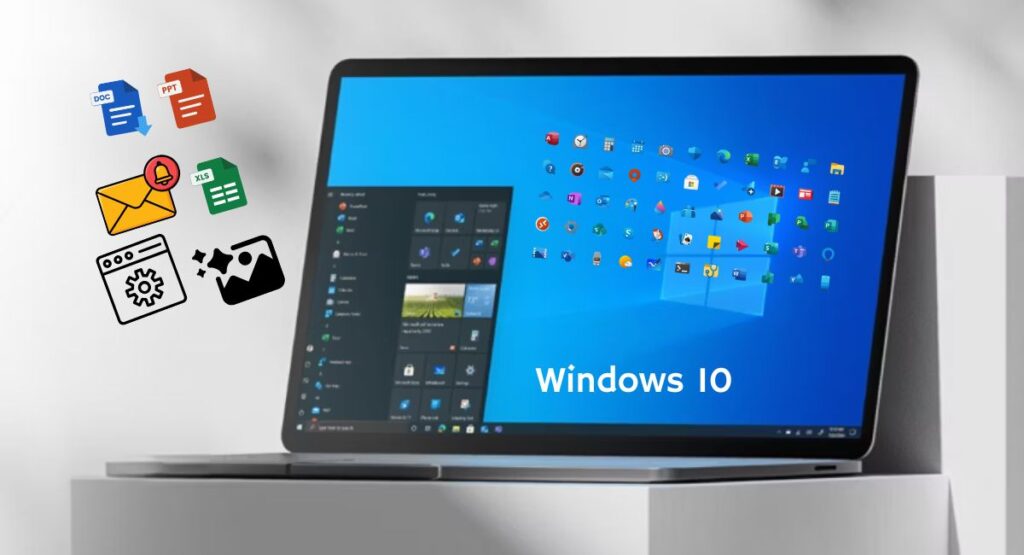October 15, 2025 — Today marks a turning point in the life of Windows 10.
On October 14, 2025, Microsoft officially announced Windows 10 End of support 2025 — shutting down free security updates, feature improvements, and technical support. (Microsoft). It’s the end of an era for one of the world’s most used operating systems.
This decision affects millions of PCs around the world.
Many users may still see their systems working, but the protection those machines once relied on is now fading. And a big question arises: what happens next for their PCs?
What “Windows 10 End of Support” Actually Means

When Windows 10 end of support system meets its deadline, Microsoft will no longer issue security patches or bug fixes for Windows 10.
That means any new vulnerability discovered after October 14 will remain unfixed on Windows 10 systems.
Windows 10 will still run, but its protection layer has officially expired. In short, Microsoft is leaving Windows 10 behind.
Important: Windows 10 won’t suddenly stop working. You can continue using it. (PCWorld)
According to Microsoft’s official page, the company will now focus its resources on Windows 11 and future versions.
In plain words, Microsoft is moving forward — and leaving Windows 10 users behind.
The Security Risks You Now Face
Continuing after Windows 10 end of support 2025 activated is just like you are driving an old car without insurance, which means your system still work, but if any security issue comes up, it exposes your entire device.
Experts warn of unpatched vulnerabilities, increased malware risks, and software incompatibility. Tom’s Guide reports that unsupported systems often become easy targets for cybercriminals. Even the best antivirus software can’t cover every missing Windows patch.
- Unpatched vulnerabilities: New exploits won’t be fixed, leaving holes for malware and attackers.
- Performance and stability issues: Without updates, compatibility with software and drivers may degrade.
- Software incompatibility: Many publishers may stop supporting Windows 10 for their apps.
Office and Microsoft 365 apps will also stop receiving support on older machines after Windows 10 End of Support 2025, according to The Verge.
This creates not just a security issue — but a productivity one too.
Security software (antivirus, firewall) can help, but it can’t fill in the gaps left by missing system-level patches. (Microsoft Learn)
Some voices are raising alarms. A lawsuit in California claims Microsoft’s cutoff leaves users “at heightened risk” with few alternatives.
Consumer groups have also petitioned Microsoft to extend free support, citing concerns about e-waste and forced obsolescence.
In cybersecurity, waiting is never a safe strategy.
What You Can Do Now: Three Paths Forward
You don’t have to stay exposed. Here are three paths users can take after Windows 10 End of Support 2025.
1. Upgrade to Windows 11 (if your PC supports it)
Microsoft encourages users to move to Windows 11, claiming it has stronger built-in, hardware-based security (e.g. TPM 2.0, secure boot) (Windows Blog)
Before upgrading, check if your hardware meets the requirements. Windows Central explains that upgrading ensures full security and compatibility.
2. Enroll in Extended Security Updates (ESU)
For Windows 10 devices, there is an Extended Security Updates (ESU) program that lets you receive critical and important security patches after Windows 10 End of Support 2025.
However, ESU has limitations:
- It does not include feature updates or technical support.
- It’s a paid option for many users.
- For consumer users, ESU may require you to link a Microsoft account (local accounts may not suffice) (Tom’s Hardware)
3. Migrate to another OS or replace your PC
If your hardware is too old, consider shifting to a supported OS (Linux distributions, ChromeOS Flex) or purchasing a new PC. These systems are secure, fast, and free — perfect for keeping older computers useful.
Why This Matters (Authority & Insight)
As a tech journalist, I see patterns: ending support is not new — Microsoft did similarly with older systems like Windows 7 and XP. But this case has a twist: Windows 10 still runs on a large share of devices worldwide. (The Guardian)
Because many PCs built in the 2010s may lack Windows 11 hardware support, a large user base is at risk. (The Verge)
Also, Microsoft’s requirement — for ESU enrollment — to use a Microsoft account is controversial. Many users prefer local accounts for privacy or simplicity.
The Windows 10 End of Support 2025 move has implications beyond security — environmental, economic, and trust-related. Forced obsolescence may push users to discard functional devices, contributing to e-waste. (WebProNews)
For journalism’s sake, I must flag that Microsoft’s official stance frames this as a lifecycle decision — older systems must yield to more secure ones. I’ve seen this cycle before — Windows XP, then Windows 7, and now Windows 10. But the difference now is scale.
No other Windows version has ever had such a huge global footprint at its end-of-life moment.
As your source, I advise: don’t wait. The longer you linger on an unsupported OS, the greater your exposure.
Interestingly, the tech world is evolving fast beyond just software changes. Even hardware makers like AMD are reshaping how companies handle AI workloads. You can read more about this shift in our coverage — AMD Stock: OpenAI’s Bold Chip Strategy — where we break down how AMD’s new partnership with OpenAI is redefining the chip race against Nvidia.
Final Word to Users
You have a decision point now. The Windows 10 End of Support 2025 decision gives both an ending and an opportunity.
An ending — because free security and support are gone.
An opportunity — because users can now transition to stronger, modern systems with better protection. check my blog on How to Transition from Windows 10 to Windows 11 Without Losing Data or Performance.
If your PC supports it, upgrade to Windows 11 soon — it gives you a smoother path forward.
If not, weigh ESU (if feasible) or shift to another reliable OS.
Most importantly: backup your data, update your software, and act before threats catch up.
Today is more than a date — it’s the moment the safety net for Windows 10 is officially gone.
Don’t let your system become tomorrow’s easy target.
Act now, and keep your digital life secure in the post–Windows 10 End of Support 2025 world.
For readers following major tech transitions, check out our feature on AMD’s partnership with OpenAI — another move changing the direction of the tech industry in 2025.
FAQs
After October 14, 2025, Microsoft no longer provides free security updates, bug fixes, or technical support for Windows 10.
Your PC will still work, but it becomes more vulnerable to security threats and software incompatibility.
After October 14, 2025, Microsoft no longer provides free security updates, bug fixes, or technical support for Windows 10.
Your PC will still work, but it becomes more vulnerable to security threats and software incompatibility.
The ESU program lets users receive paid security updates for a limited time after Windows 10 End of Support 2025.
It’s designed for users who can’t immediately upgrade to Windows 11 but still want critical patches.
You can upgrade to Windows 11, use the ESU program, or switch to a supported OS like Linux or ChromeOS Flex.
Each option keeps your PC protected and compliant with modern security standards.
